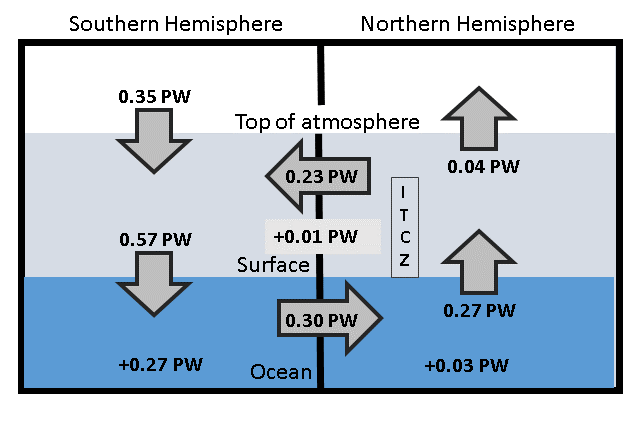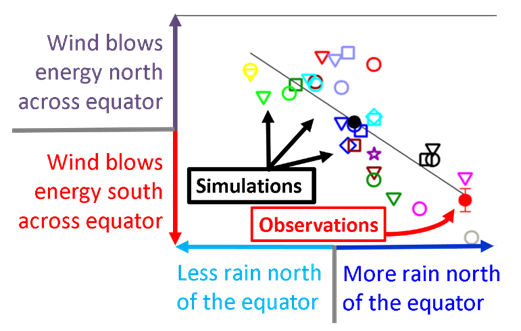By Richard Allan
The subtle differences in the way heat is distributed between the northern and southern hemispheres, either side of the equator, are important in determining global rainfall patterns and climate. Over many tens of thousands of years, periodic cycles in Earth’s orbit around the sun initiate massive glacial to interglacial swings in climate and the changes in heating between hemispheres cause profound past shifts in the tropical rainy belt with huge impacts on ecosystems. Recent work to observe and simulate the current hemispheric heating imbalance also highlight its great importance for present human societies.
Land generally reflects more sunlight than dark ocean surfaces. Yet although most (around two thirds) of the global land surface area is contained in the northern hemisphere, observations show a remarkable symmetry in hemispheric albedo (both hemispheres reflect just as much sunlight over the course of the year) and this symmetry is additionally explained by the greater cloudiness in the south. However, thermal infra-red energy emitted to space also affects heating differences between each hemisphere and satellite observations show that the southern hemisphere emits less infrared radiation to space and therefore absorbs more energy overall than the northern hemisphere, as depicted in the diagram below.

The diagram above (updated from Loeb et al. (2015) using data from Liu et al. (2015) for June 2000 to May 2015 and other sources included in references and notes below) shows that 0.35 petawatts (PW: millions of billions of watts of energy flux) is building up in the southern hemisphere while the northern hemisphere is actually losing more energy to space than it is gaining, despite the fact that the surface is warming up! How can this be?
Here’s how things seem to stack up:
- (1) Earth is heating up: there is more energy arriving than leaving our planet. Averaging both hemispheres, this amounts to 0.35 – 0.04 = 0.31 petawatts (or 0.6 watts per square metre if you divide by Earth’s surface area of 510 million million square metres). Almost all of this excess energy accumulates in, and warms, the oceans; the rest warms the air (calculated as +0.01 petawatts) and also heats up the solid ground and expends energy melting ice.
- (2) Much of this ocean heating is in the southern hemisphere (+0.27 petawatts, see notes below)
- (3) The oceans (mainly the Atlantic) are transporting huge quantities of energy across the equator from the south to the north (0.30 petawatts in the diagram)
- (4) Much of this transported energy is released into the atmosphere north of the equator (calculated as 0.27 petawatts)
- (5) This extra heating of the northern hemisphere atmosphere affects the global atmospheric circulation and explains why the tropical rainy belt (or Inter Tropical Convergence Zone, ITCZ) is more in the northern hemisphere than the south
- (6) The position of the tropical rainy belt helps move a large fraction of the heat transported by the ocean back south of the equator by the atmospheric winds (around 0.23 petawatts). A startling further result from our analysis is that many sophisticated computer simulations, that are used to make projections of future climate change, are unable to simulate the correct energy flow in the atmosphere between hemispheres. Whereas the observations show a southward movement of energy, many simulations produce the reverse.

Above: A schematic showing simulations (open symbols) that produce a northward flow of energy across the equator produce less rainfall north of the equator than south of the equator which disagrees with observations (filled red circle) [source: Loeb et al. (2015), Figure 7d] We also find that the simulations with the wrong direction of atmospheric energy flow between hemispheres also simulate more rainfall in the southern hemisphere than the northern hemisphere, again the reverse of what occurs in the real world (see schematic above). This is important because it offers a new perspective on how to improve our climate simulations.
Global rainfall patterns, including monsoon systems that are part of the tropical rainy belt, are of utmost importance to human societies. So this is an important and exciting area of research and we hope to make further progress in observing, simulating and understanding how energy flows and rainfall patterns are changing as the climate continues to be affected by human-caused emission of greenhouse gases and other pollutants.
-
[Research is ongoing under the DEEP-C and SMURPHS projects funded by the Natural Environment Research Council].
References
Broecker & Putnam (2013) Hydrologic impacts of past shifts of Earth’s thermal equator offer insight into those to be produced by fossil fuel CO2, PNAS, doi: 10.1073/pnas.1301855110
Dong and Sutton (2015) Dominant role of greenhouse-gas forcing in the recovery of Sahel rainfall, Nature Clim. Ch., doi: 10.1038/nclimate2664
Frierson et al. (2013) Contribution of ocean overturning circulation to tropical rainfall peak in the Northern Hemisphere, Nature Geoscience, doi: 10.1038/ngeo1987
Haywood et al. (2016) The impact of equilibrating hemispheric albedos on tropical performance in the HadGEM2-ES coupled climate model, Geophys. Res. Lett., doi:10.1002/2015GL066903
Liu et al. (2015) Combining satellite observations and reanalysis energy transports to estimate global net surface energy fluxes 1985-2012, J. Geophysical Research, doi:10.1002/2015JD023264
Loeb et al. (2015) Observational Constraints on Atmospheric and Oceanic Cross-Equatorial Heat Transports: Revisiting the Precipitation Asymmetry Problem in Climate Models, Climate Dynamics, doi:10.1007/s00382-015-2766-z
Maidment et al. (2015) Recent observed and simulated changes in precipitation over Africa,Geophys. Res. Lett., doi: 10.1002/2015GL065765
Roemmich et al. (2015) Unabated planetary warming and its ocean structure since 2006, Nature Climate Change, doi: 10.1038/nclimate2513
Stephens, G. L., D. O’Brien, P. J. Webster, P. Pilewski, S. Kato, and J. Li (2015), The albedo of Earth. Rev. Geophys., 53, 141-163. doi:10.1002/2014RG000449
Notes
The energy flow diagram is calculated as follows:
(1) Top of atmosphere/surface fluxes are from the Liu et al. (2015) Version 2 geodetic weighting product. The +0.01 petawatt term represents heating of the northern and southern hemisphere atmosphere; the atmospheric heat transport is calculated using the method in Loeb et al. (2015) as 0.5x((0.35 – –0.04) + (0.57 – 0.27)) = 0.23 PW.
(2) Upper ocean (0-2000m depth) heating is 0.228 PW in the south and 0.025 PW in the north based on results for 2006-2013.
(3) Consistent with previous work, I assume an additional 0.035 PW of heating of the deep ocean (primarily in the south) while heating of the ground (including ice) and melting of ice is estimated as another 0.01 PW (70% of which is assumed to affect the northern hemisphere due to the greater land mass)
(4) From this I estimate that 0.27 PW (0.228 + 0.035 + 0.003 = 0.266 PW) is being stored in the southern hemisphere ocean and 0.03 PW (0.025 + 0.007 = 0.032 PW) is being stored in the northern hemisphere ocean but including within both estimates the small heating of land and heating/melting of ice (0.003 + 0.007 PW).
(5) The ocean heat transport is calculated using equation (4) from Loeb et al. (2015): 0.5x((0.57 – –0.27) – (0.27 – 0.03)) = 0.30 PW.
